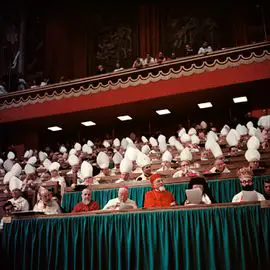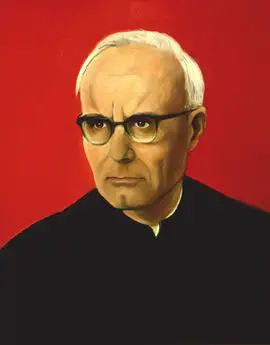How did Vatican II change the Catholic Church
Introduction
In 1959 Pope John XXIII called for an ecumenical council of the Catholic Church that would later be known at Vatican II. As a result of this council, the Catholic Church would dramatically change or reconsider its stance towards the world, it’s celebration of the liturgy, salvation, and the roles of clergy and the laity. Ending in 1965, the council would engender much debate, and even some reluctancy, by many conservative factions within the Church. However, despite the growing pains that resulted from its declarations, it drastically redefined what it meant to be Catholic in the world and evidenced the Church’s desire to speak directly to the modern man.What is an Ecumenical Council?
Historically, the way that the Catholic Church decides doctrinal debates and moral teaching is through dialogue among church authorities and officials--this is what is traditionally called a council or synod. The Catholic Church distinguishes between two types of councils, ecumenical councils and synods or provincial councils. Ecumenical councils are authoritative while synods or provincial councils are mere discussions that do not retain any authoritative status. The very first ecumenical council was the Council of Nicea (convened in the fourth century) and was mainly a response to what is known in Church History as the “Arian Crisis,” a heretical teaching about the Trinity which purported that Jesus Christ was created by God the Father, verses being con-substantial with the Father.[1]During this council the Nicene Creed as formulated, which is still used and recited during services today. The last ecumenical council happens to Vatican II, the topic of our discussion in this article. In the words of Pope John XXIII, “The major interest of the Ecumenical Council is this: that the sacred heritage of Christian truth be safeguarded and expounded with greater efficacy.”[2]In other words, this council was convened in order to renew and reinvigorate the life of the church and to refine the sacred deposit of faith.</ref>
The Church in the Modern World
In Gaudium et Spes(Joy and Hope in Latin), authored in and through the proceedings of Vatican II, the Church spoke explicitly about the current state of modern world, the growth of the secular sphere and the withdrawal from religion. It specified and clarified that the Church as a collective institution is not opposed to science, philosophy, technology or culture as many might perceive religion to be in opposition to these things. Instead, it reaffirmed that She saw these as goods. These goods only become corrupted, said the council, when they in themselves are upheld as man’s highest ends. The council strongly and unabashedly declared that because man was made for communion God and that the goods of science, philosophy, technology and culture would be empty--insufficient when sought as final ends in themselves. The Council continues in stating that Church’s mission is to bring Christ to the world. The religious life should inform the political or public life. Being a Christian, a Catholic specifically, means allowing the love of God to radically transform your whole being, not just when one is at home in isolation: “This split between the faith which many profess and their daily lives deserves to be counted among the more serious errors of our age. Long since, the Prophets of the Old Testament fought vehemently against this scandal and even more so did Jesus Christ Himself in the New Testament threaten it with grave punishments. Therefore, let there be no false opposition between professional and social activities on the one part, and religious life on the other.”[3] All in all, the council’s message was one of not retreating from the world, but going forth into it with vigor, ardor and eagerness to share the Gospel.
The Clergy and the Laity
Perhaps one of the greatest revivals of Vatican II was restoring what the council designated as “baptismal dignity.” The Church re-articulated that by virtue of the sacrament of baptism each member of the faithful incurred a priestly, prophetic, and kingly dignity. The priestly dignity is in reference to a call to holiness, the prophetic to a call to preach the word of the Gospel, and the kingly to be leaders in the Church. While this was not new, the council re-established that holiness, preaching the word, and leading were not only duties conferred unto the clergy, affirming that the laity shouldn’t be passive recipients of the sacraments, but active participants in the Church. In many ways this served as a correction to clericalism that had been historically rampant in the Church and as a call to action to the monotonous church-goers that were not living out the Christian life in the secular world. It also reinforced that the laity were not merely meant to be served by the church, but they needed to reciprocally serve The Church in the world.[4]
Liturgical Changes
Perhaps some of the most startling changes in the life of the church were those pertaining to the celebration of the Mass. Even if Catholics were not following the progress and discussions of the council or reading the declarations it produced, they would be immediately faced with the changes to the liturgy every Sunday in the pews.
Prior to the close of Vatican II every Catholic Mass was conducted in Latin. As one might suspect, many Catholics, especially in countries with high amounts of poverty and low literacy rates, did not know Latin or have the opportunity to learn it. Thus, in order to make the Mass more relatable, inclusive, and open to active participation, the Catholic Church decided Mass should be held in the vernacular, or the language that the people of the area spoke. So, if you were in Chicago, Illinois you would hear the Mass in English. If you were in Paris, France you would hear it in French, etc. Other changes included affording women the ability to take a more active role in the liturgy, primarily in allowing girls to be altar servers (this was previously only an opportunity afforded to males). Further, the laity were given the chance to serve as eucharistic ministers, and lectors (roles formerly performed by members of the clergy only). Though there were many other changes in the liturgy produced, these were merely the most impactful and revolutionary.
Considerations in Soteriology
One other main theological evolution of the council was its consideration of salvation outside of the Catholic Church. Prior to Vatican II it had long been the position of the Church that participation in the sacrament and belonging to the Catholic communion were essential for salvation. Though the Church still claims it is the medium through which God chose to extend salvation to mankind, it very explicitly suggested that salvation for those not belonging to the Catholic Church was certainly possible. Karl Rahner’s theology of the “Anonymous Christian” was particularly influential in the development of this doctrine. According to Rahner, it is entirely possible that an individual not belonging to the Church explicitly could be part of the church through the way they live according to their conscience and the demands of natural law. However, Rahner explicitly contends this theory is only applicable in cases where an individual is ignorant of the Gospel, not in cases where it is merely rejected. This approach is known as Constitutive Inclusivism. It states Christ and the Church are necessary for salvation, but asserts the possibility of God saving someone who does not belong to the Church.[5]Conclusion
Again, these points discussed above are merely scratching the surface of the changes implemented by Vatican II. Many of its promulgations are still in the process of being realized in parishes and dioceses around the globe. However, Vatican II stands as the largest, and perhaps most surprising, ecumenical councils convened in the Church’s history.
References
- ↑ For more on the Arian Crisis see: Irvin & Sunquist, History of the World Christian Movement. (Maryknoll, New York: Orbis, 2008).
- ↑ Pope John XXIII. Opening Address to the Vatican II Council, October 11,1962.
- ↑ Vatican Council, Edward H. Peters, and Gregory Baum. Second Vatican Council, “Gaudium et spes: The Constitution on the Church in the Modern World” in The Documents of Vatican II, ed. Walter M. Abbott (New York: Guild Press, 1966), #41.</span> </li>
- ↑ Second Vatican Council, “Lumen gentium: Dogmatic Constitution on the Church” in The Documents of Vatican II, ed. Walter M. Abbott (New York: Guild Press, 1966).
- ↑ For more on Karl Rahner’s "Anonymous Christian" see: Kilby, Karen. <i>Karl Rahner: Theology and Philosophy </i>. (London: Routledge, 2004).
</ol>
Admin, Lmking2 and EricLambrecht

